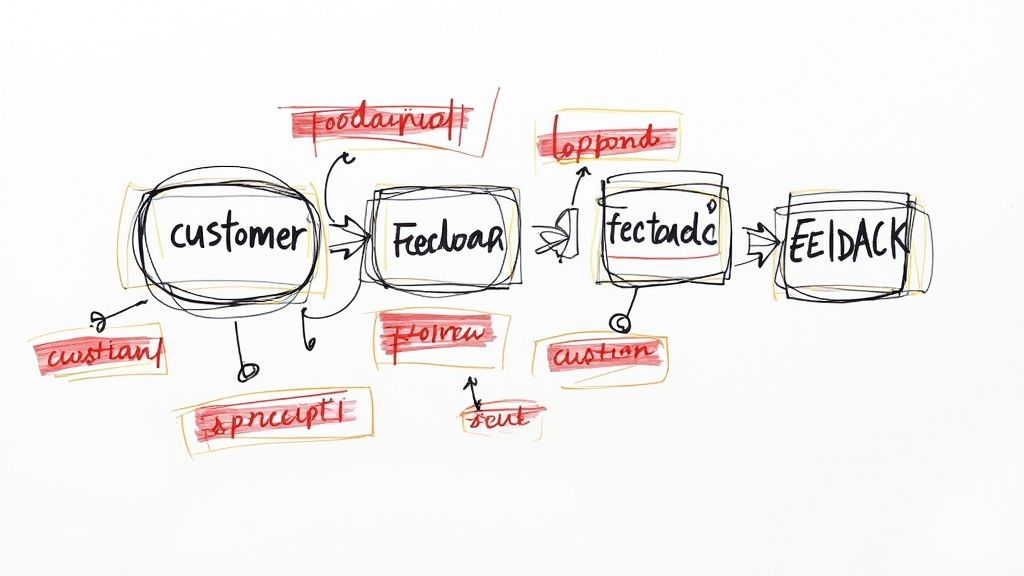Customer Retention Strategies That Drive Growth
Understanding Why Customer Retention Changes Everything

When businesses focus on keeping their existing customers happy, amazing things start to happen. It's not just about preventing customers from leaving - it's about building real relationships that lead to long-term growth. Take loyalty programs, for example. What started as simple paper punch cards at local diners in the 1950s has grown into sophisticated rewards systems that truly influence how and where people shop. This evolution shows just how much customer retention strategies have grown to match changing consumer needs.
The Financial Impact of Retained Customers
The numbers behind customer retention tell a compelling story. Research shows that increasing customer retention by just 5% can boost profits anywhere from 25% to 95%. This means that small improvements in how you treat your current customers can lead to major gains for your business. Even more interesting is that repeat customers tend to spend up to 67% more than new ones. These statistics highlight why turning first-time buyers into loyal fans should be a top priority.
Why Customers Stay (and Why They Leave)
To keep customers coming back, you need to understand both what makes them stay and what drives them away. Companies that excel at retention consistently deliver smooth, positive experiences at every touchpoint. This includes things like clear onboarding steps, personal communication, and quick problem-solving when issues come up. On the flip side, slow response times, generic mass emails, and complicated return policies can quickly push customers toward your competitors.
Retention Rates Across Industries
Different industries see widely varying customer retention rates. Media companies and professional service firms often see retention rates as high as 84%, largely due to their focus on building strong client relationships and delivering personalized service. Meanwhile, restaurants, hotels, and travel companies typically hover around 55% retention. These differences show why each industry needs its own approach - a restaurant might focus on creating memorable experiences and special offers, while a software company might prioritize ongoing support and regular updates.
Calculating the Value of a Retained Customer
Understanding the true worth of a loyal customer requires looking beyond single purchases to see their full long-term potential. A thorough analysis considers factors like how often they buy, how much they typically spend, and how many new customers they bring through word-of-mouth referrals. Tracking these metrics helps businesses make smart decisions about where to invest their resources and which retention strategies deserve the most attention. Armed with this insight, companies can build genuine loyalty that pays off for years to come.
Creating Loyalty Programs People Actually Love
We've seen why customers stay loyal to brands. Now let's explore how to create loyalty programs they'll genuinely value and use. The days of simple paper punch cards are long gone. When American Airlines launched AAdvantage in 1981, it changed how businesses think about customer loyalty. Their points-based system became a model across industries. Research shows that effective loyalty programs can double the likelihood of repeat purchases at stores like supermarkets - proving just how much impact a well-designed program can have on customer retention.
Beyond Points: Designing for Engagement
Points alone won't keep customers coming back. The most effective modern loyalty programs create real connections with members. Take Sephora's Beauty Insider program as an example. Members don't just earn points - they get exclusive events, personalized recommendations, and join a vibrant community of beauty enthusiasts. The program taps into what customers really want: to feel special, belong to a group, and receive service tailored to their needs.
Key Elements of Successful Loyalty Programs
What makes customers love and actively use a loyalty program? Here are the essential components:
- Experiential Rewards: Give members special access to events, early product launches, or one-on-one consultations. These create memories that build stronger emotional bonds with your brand.
- Tiered Structure: Set up levels that members can progress through over time. This adds a fun challenge that motivates people to engage more deeply with your brand.
- Personalized Communication: Send messages that reflect each member's preferences and purchase history. Mass emails feel impersonal and often get ignored.
- Seamless Integration: Make it simple to join and use the program. Starbucks Rewards shows how smooth this can be when built right into a mobile app.
- Community Building: Help members connect with each other to share tips and experiences. This creates a sense of belonging that strengthens their connection to your brand.
Avoiding Common Loyalty Program Pitfalls
Even great loyalty programs can stumble. Here are key problems to watch out for:
| Pitfall | Explanation |
|---|---|
| Complex Program Structure | When rules get confusing, members give up trying to participate |
| Irrelevant Rewards | Offering perks members don't actually want wastes everyone's time |
| Poor Communication | Members drift away when benefits and changes aren't clearly explained |
| Inconsistent Experience | Trust suffers when the program doesn't match your usual customer service |
Focus on creating real value for your members while avoiding these common mistakes. This helps build the kind of loyalty program that not only keeps customers coming back, but turns them into true fans who stick with your brand for the long run. That lasting loyalty drives sustainable growth through increased customer lifetime value.
Building Customer Experiences That Keep People Coming Back

Getting customers to come back takes more than just a good loyalty program. The real key is creating experiences that make them want to return again and again. Every interaction matters - from when someone first discovers your brand to how you support them after purchase. For example, making it super easy for new customers to get started with your product or service dramatically increases the chances they'll stick around. Let's explore how to craft these experiences in a way that builds lasting customer relationships.
Mapping the Customer Journey for Retention
To boost customer retention, you first need to understand their complete journey with your business. This means tracking every time they interact with you - whether they're browsing your website, engaging with your social media posts, making a purchase, reaching out to support, or leaving a review. By looking at this journey as a whole, you can spot where things might go wrong and find ways to make the experience better. This helps you fix potential issues before customers decide to leave.
Identifying Opportunities for Improvement
After mapping out how customers interact with your business, look for specific areas you can make better. Maybe your checkout process needs to be simpler, your email messages could be more personal, or your support team could reach out to help before customers have problems. Ask for feedback through surveys and reviews to learn what your customers really want. Just remember - collecting feedback only helps if you actually use it to make changes.
Implementing Changes That Matter
When making changes to keep customers coming back, focus on what will have the biggest positive impact. Start with the issues that frustrate customers the most. For instance, if lots of people complain about slow shipping, investing in faster delivery options could make a huge difference in their experience. When you make these improvements, let customers know about them. This shows you're listening and actually care about making things better for them.
Creating Memorable Moments
Turning one-time buyers into loyal fans happens when you create experiences they'll remember. Simple gestures like sending a personal thank-you note, offering a special discount just for them, or going above and beyond to solve their problem can leave a lasting impression. Think about how different it feels to get an automated email versus a handwritten note from the business owner. That personal touch creates a real connection. Happy customers become your best advertisers, telling others about their great experiences. When you focus on building real relationships and exceeding expectations, you create the kind of loyalty that helps your business grow naturally over time.
Mastering Data-Driven Personalization at Scale

Creating memorable customer experiences is key to keeping customers coming back. When businesses personalize interactions based on real customer data, they make those experiences even more meaningful and effective. Companies like Netflix and Spotify show how powerful this can be - they keep users engaged by suggesting content that matches their unique tastes and viewing history. The key is using customer data thoughtfully to improve experiences without crossing privacy boundaries.
Collecting and Analyzing Customer Data for Actionable Insights
Good personalization starts with smart data collection across all customer touchpoints. This means paying attention to more than just basic contact information - it's about understanding how customers interact with your brand. What products catch their eye? Which content do they read? How do they engage on social media? When analyzed carefully, these details paint a clear picture of what customers want and need. For instance, if someone frequently looks at running shoes on your website but hasn't made a purchase, you could send them a targeted email about new arrivals or a special offer on athletic footwear.
Predicting Behavior Patterns to Anticipate Customer Needs
Understanding past customer behavior helps businesses spot patterns and prepare for future needs. This forward-thinking approach allows companies to solve problems before they arise and delight customers with timely suggestions. Just as Netflix knows what show you might enjoy next, businesses can anticipate their customers' upcoming needs and meet them proactively. For example, sending product recommendations based on previous purchases or reaching out with support resources after noticing signs of difficulty can show customers you're paying attention and care about their success.
Creating Targeted Experiences That Resonate With Individual Customers
The real power of personalization comes from turning data insights into meaningful customer experiences. Rather than blasting generic promotions to everyone, successful businesses craft messages and offers that speak directly to individual interests and needs. Think about receiving a discount for something you've been considering buying, or helpful tips related to a product you just purchased. These thoughtful touches show customers you understand them, building stronger connections than any mass marketing campaign could achieve.
Balancing Automation and the Human Touch
While automated systems make large-scale personalization possible, maintaining genuine human connections matters too. Relying too heavily on automation can make interactions feel cold and robotic. Simple gestures like personal video messages from leadership or handwritten notes for loyal customers can make a big difference in building trust. The most effective approach combines efficient automation with authentic human moments. Being clear about how customer data is collected and used is also crucial - customers need to feel confident their information is handled responsibly and their privacy is protected.
Measuring What Really Matters in Customer Retention
Creating sustainable growth requires finding the right balance between bringing in new customers and keeping existing ones happy. Much like a doctor monitoring vital signs, businesses need to track specific metrics that reveal the true health of their customer relationships. The key is identifying which measurements matter most for your specific business model and industry.
Key Metrics for Measuring Customer Retention Success
To make smart decisions about keeping customers, you need to focus on metrics that provide real insight. Here are the essential numbers to watch:
- Customer Retention Rate: This core metric shows what percentage of customers stay with your business over time. For example, if you start a quarter with 200 customers, gain 40 new ones, and end with 220 total customers, your retention rate is 90%. Since keeping existing customers costs less than finding new ones, a strong retention rate directly impacts your bottom line.
- Customer Churn Rate: While retention rate looks at who stays, churn rate reveals who leaves during a specific period. A rising churn rate often points to problems with your product, support, or customer experience that need quick attention. Tracking this number helps you spot and fix issues before more customers walk away.
- Customer Lifetime Value (CLTV): Looking beyond single purchases, CLTV estimates how much revenue you can expect from the entire customer relationship. This helps you identify your most valuable customers and decide how much to invest in keeping different customer groups happy.
- Repeat Purchase Rate: This shows what percentage of customers buy from you more than once. A high rate means customers like what you offer and keep coming back. Programs that reward loyalty and personalized product suggestions can help boost this number even higher.
- Purchase Frequency: This tracks how often customers return to buy within a set timeframe. Understanding these patterns lets you time your marketing just right. If data shows customers typically buy every three months, you can plan promotions to match their natural buying cycle.
Using Data to Drive Retention Initiatives
While these metrics provide valuable insights, simply collecting numbers isn't enough. Like a pilot using instruments to stay on course, you need to actively use this data to guide your retention strategy. This means testing different email campaigns, personalizing how you welcome new customers, and making changes based on what customers tell you works and doesn't work.
For instance, media companies often achieve 84% retention rates by providing highly personalized service. Other industries can learn from this example - using customer data to create more personal, relevant experiences. The key is not just measuring what matters, but taking action on those insights to keep customers coming back.
Putting Your Retention Strategy into Action

After analyzing customer data, identifying pain points, and designing a loyalty program, it's time to put your customer retention strategy into practice. This critical phase requires careful planning and consistent execution. Like tending to a garden, building strong customer relationships takes ongoing care and attention. Success depends on setting clear priorities, getting your whole team aligned, and maintaining steady progress over time.
Building Cross-Functional Alignment for Retention
Customer retention isn't just for the support team - it needs everyone's involvement. Marketing teams can run targeted campaigns to bring back inactive customers. Product teams can use feedback to fix issues causing customers to leave. Sales teams can focus on bringing in customers who are likely to stay long-term. Even finance plays a role by analyzing the costs and returns of retention programs. When every department works together, you create a better overall experience that keeps customers coming back.
Overcoming Common Obstacles in Retention Efforts
Every retention strategy faces some common challenges along the way. Getting enough budget and resources often requires showing leaders clear proof that retention efforts pay off through metrics and case studies. Keeping programs running consistently over time, rather than launching and forgetting them, takes dedication. Measuring results accurately helps track what's working and guides improvements. Focus on key numbers like retention rate, customer lifetime value, and churn rate to stay on track.
Maintaining Momentum and Adapting Your Strategy
Customer needs and expectations change constantly, so retention strategies need regular updates to stay effective. Keep tabs on what's working well in your industry, what competitors are doing, and most importantly - what your customers are saying. For example, if multiple customers complain about the same issue, act quickly to fix it. Show them you're listening and care about their experience. This responsive approach helps prevent customer losses before they happen.
Practical Roadmap for Implementation
To put your retention strategy into action effectively, follow these key steps:
- Prioritize Quick Wins: Begin with simple changes that show fast results. Early successes build momentum and prove the strategy's worth.
- Develop a Timeline: Create clear schedules for each part of your retention plan. This keeps everyone focused and accountable.
- Define Success Metrics: Pick specific numbers to track how well your retention efforts work. Check these regularly to spot what needs improvement.
Think of your implementation plan like a map - it guides your team step by step toward better customer retention. Clear direction helps everyone stay focused on the same goals.
Want to transform customer interactions and boost retention with a personalized AI chatbot? Check out Sitebot today!


